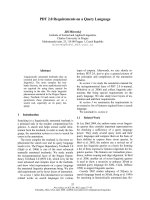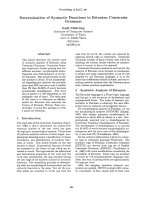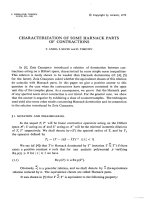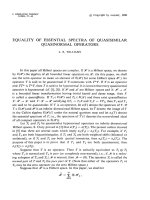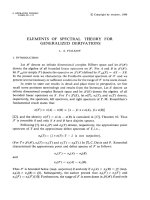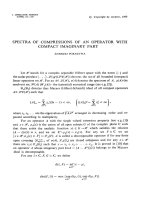Báo cáo toán học: "Compositions of Random Functions on a Finite Set" ppt
Bạn đang xem bản rút gọn của tài liệu. Xem và tải ngay bản đầy đủ của tài liệu tại đây (91.36 KB, 7 trang )
Compositions of Random Functions on a Finite Set
Avinash Dalal
MCS Department, Drexel University
Philadelphia, Pa. 19104
Eric Schmutz
Drexel University and Swarthmore College
Philadelphia, Pa., 19104
Submitted: July 21, 2001; Accepted: July 9, 2002
MR Subject Classifications: 60C05, 60J10, 05A16, 05A05
Abstract
If we compose sufficiently many random functions on a finite set, then the
composite function will be constant. We determine the number of compositions
that are needed, on average. Choose random functions f
1
,f
2
,f
3
, independently
and uniformly from among the n
n
functions from [n]into[n]. For t>1, let
g
t
= f
t
◦ f
t−1
◦ ···◦ f
1
be the composition of the first t functions. Let T be
the smallest t for which g
t
is constant(i.e. g
t
(i)=g
t
(j) for all i, j). We prove that
E(T ) ∼ 2n as n →∞,whereE(T ) denotes the expected value of T .
1 Introduction
If we compose sufficiently many random functions on a finite set then the composite
function is constant. We ask how long this takes, on average. More precisely, let
U
n
be the set of n
n
functions from [n]to[n]. Let A
n
be the n element subset
of U
n
consisting of the constant functions: g ∈ A
n
iff g(i)=g(j) for all i, j.Let
f
1
,f
2
,f
3
, be a sequence of random functions chosen independently and uniformly
from U
n
.Letg
1
= f
1
,andfort>1letg
t
= f
t
◦g
t−1
be the composition of the first
t random maps. Define T(f
i
∞
i=1
) to be the smallest t for which g
t
∈ A
n
.(Ifno
such t exists, define T = ∞. It is not difficult to show that Pr(T = ∞)=0.)Our
goal in this paper is to estimate E(T ).
It is natural to restate the problem as a question about a Markov chain. The
state space is S = {s
1
,s
2
, ,s
n
}.Fort>0andr ∈ [n], we are in state s
r
if and
only if g
t
has exactly r elements in its range. With the convention that g
0
is the
identity permutation, we start in state s
n
at time t = 0. The question is how long
(i.e. how many compositions) it takes to reach the absorbing state s
1
.
For m>1, let τ
m
= |{t : |Range(g
t
)| = m}| betheamountoftimewearein
state s
m
.ThusT =
n
m=2
τ
m
.LetT consist of those states that are actually visited:
the electronic journal of combinatorics 9(1)(2002), #R26 1
for m>1, s
m
∈T iff τ
m
> 0. The visited states T are a (non-uniform) random
subset of S that includes at least two elements, namely s
n
and (with probability 1)
s
1
. We prove later that T typically contains most of the small numbered states and
relatively few of the large numbered states. This observation forms the basis for our
proof of
Theorem 1 E(T )=2n(1 + o(1)) as n →∞.
We should mention that there is a standard approach to our problem using the
transition matrix P and linear algebra. Let Q be the matrix that is obtained from
P by striking out the first row and column of P .ThenE(T ) is exactly the sum of
the entries in the last row of (I − Q)
−1
. See, for example, chapter 3 of [5]. This
fact is very convenient if one wishes to compute E(T ) for specific small values of n.
An anonymous referee conjectured that E(T )=2n − 3+o(1) after observing that,
for small values of n, |E(T ) −2n +3|≤1. This conjecture is plausible, but we are
nowhere near a proof.
2 The Transition Matrix
The n×n transition matrix P can be determined quite explicitly. Suppose g
t−1
has
i elements in its range, How many functions f have the property that f ◦ g
t−1
has
exactly j elements in its range? There are
n
j
ways to choose the j-element range
of f ◦ g
t−1
,andS(i, j)j!waystomapthei-element range of g
t−1
ontoagivenj
element set. (Here S(i, j) is the number of ways to partition an i element set into
j disjoint subsets, a Stirling number of the second kind.) Finally, there are n − i
elements in the complement of the range of g
t−1
,andn
n−i
ways to map them into
[n]. Thus there are
n
j
S(i, j)j!n
n−i
functions f with the desired property, and for
1 ≤ i, j ≤ n, the transition matrix for the chain has i, j’th entry
P (i, j)=
n
j
S(i, j)j!
n
i
. (1)
The stationary distribution π assigns probability 1 to s
1
. The transition matrix
has some nice properties. It is lower triangular, which means the eigenvalues are
just the diagonal entries: for 1 ≤ m ≤ n,
λ
m
= P(m, m)=
m−1
k=0
(1 −
k
n
). (2)
For future reference we record two simple estimates for the eigenvalues, both of
which follow easily from (2).
Lemma 2
λ
m
=1−
m
2
n
+ O(
m
4
n
2
)
and
λ
m
≤ exp(−
m
2
/n).
the electronic journal of combinatorics 9(1)(2002), #R26 2
3 Lower Bound
The proof of the lower bound requires an estimate for the Stirling numbers S(m, k).
The literature contains many precise but complicated estimates for these numbers.
Here we prove a crude inequality whose simplicity makes it convenient for our pur-
poses.
Lemma 3 For all positive integers m and k, S(m, k) ≤ (2k)
m
.
Proof: The proof of this lemma will be done by induction using the recurrence
S(m, k)=S(m − 1,k−1) + kS(m − 1,k). When k = 1, we know that S(m, 1) = 1
and (2k)
m
=2
m
. So clearly the inequality holds true for k = 1 (for all positive
integers m).
Now let φ
m
denote the following statement: for all k>1, S(m, k) ≤ (2k)
m
. It
suffices to prove that φ
m
is true for all m.Form =1,S(1,k)=0≤ 2k for all k>1.
Now let k>1 and assume, inductively, that φ
m−1
is true (i.e. S(m−1,k) ≤ (2k)
m−1
for k>1.)Thenwehave
S(m, k)=S(m − 1,k−1) + kS(m −1,k) ≤ (2(k −1))
m−1
+ k(2k)
m−1
=(2k)
m
1
2
+
(k − 1)
m−1
2k
m
.
Realize that the quantity inside the large braces is less than one.
With lemma 3 available, we can proceed with the proof that E(T ) ≥ 2n(1+o(1)).
Since T =
n
m=2
τ
m
,wehave
E(T )=
n
m=2
Pr(s
m
∈T)E(τ
m
|s
m
∈T). (3)
Obviously a lower bound is obtained by truncating this sum. To simplify notation,
let = log log n. Then
E(T ) ≥
m=2
Pr(s
m
∈T)E(τ
m
|s
m
∈T). (4)
To estimate the second factor in each term of (4), note that
E(τ
m
|s
m
∈T)=
∞
t=1
tλ
t−1
m
(1 −λ
m
)=
1
1 −λ
m
. (5)
Applying lemma 2, we get
E(τ
m
|s
m
∈T)=
n
m
2
(1 + O(
m
2
n
)). (6)
To estimate the first factor of each term in (4), we make the following observation:
if s
m
∈ T , then there is a transition from s
m+d
to s
m−j
for some positive integers
d and j. Hence,
the electronic journal of combinatorics 9(1)(2002), #R26 3
Pr(s
m
∈ T )=
n−m
d=1
m−1
j=1
Pr(s
m+d
∈T)
P (m + d, m − j)
(1 −λ
m+d
)
. (7)
(The factor (1 − λ
m+d
)
−1
=
∞
i=0
P (m + d, m + d)
i
is there because we remain in
state s
m+d
for some number of transitions i ≥ 0beforemovingontostates
m−j
.)
Let σ :=
n−m
d=1
m−1
j=1
S(m+d,m−j)
n
j+d
λ
m−j
1−λ
m+d
. Putting (1) and Pr(s
m+d
∈T) ≤ 1into
(7), we get
Pr(s
m
∈ T ) ≤
n−m
d=1
m−1
j=1
1 ·
n
m −j
S(m + d, m − j)(m − j)!
n
m+d
(1 −λ
m+d
)
= σ. (8)
A first step in bounding σ is to note that 1 > (1−
1
n
)=λ
2
≥ λ
3
≥ λ
4
≥ ≥ λ
n
> 0,
and therefore
λ
m−j
1 −λ
m+d
≤
1
1 − λ
m+d
≤
1
1 −λ
2
= n − 1.
Hence
σ ≤ (n −1)
n−m
d=1
1
n
d
m−1
j=1
S(m + d, m − j)
n
j
.
Applying lemma 3 to each term of the inside sum, we get
m−1
j=1
S(m + d, m −j)
n
j
≤
m−1
j=1
(2(m − j))
m+d
n
j
≤
m(2m −2)
m+d
n
<
(2)
+d
n
.
Hence
σ ≤ (n −1)
(2)
n
n−m
d=1
(
2
n
)
d
= O(
(2)
+2
n
)=o(1).
Thus Pr(s
m
∈T) ≥ 1 − o(1) for all m ≤ , Putting this and (6) back into (4),
and using the fact that
m=2
1
(
m
2
)
=
m=2
(
2
m−1
−
2
m
)=2−
2
, we get the lower bound
E(T ) ≥ 2n(1 + o(1)).
4 Upper Bound
If |Range(g
t−1
)| = m, then the restriction of f
t
to Range(g
t−1
) is a random function
from an m element set to [n]. Before proving that E(T ) ≤ 2n(1 + o(1)), we gather
a simple lemma about the size of the size of the range for such random maps.
Lemma 4 Suppose h :[m] → [n] is selected uniformly at random from among
the n
m
functions from [m] into [n],and let R be the cardinality of the range of h.
Then the mean and variance of R are respectively E(R)=n − n(1 −
1
n
)
m
and
Var(R)=n
2
{(1 −
2
n
)
m
− (1 −
1
n
)
2m
} + n{(1 −
1
n
)
m
− (1 −
2
n
)
m
}.
the electronic journal of combinatorics 9(1)(2002), #R26 4
Proof: Let U = n − R =
n
i=1
I
i
,whereI
i
is 1 if i is not in the range of h,and
otherwise I
i
is zero. Then E(R)=n −E(U), and Var(R)=Var(U).
E(U)=nE(I
1
)=n(1 −
1
n
)
m
. (9)
E(U
2
)=
i=j
E(I
i
I
j
)+E(U)
= n(n − 1)(1 −
2
n
)
m
+ E(U).
Therefore
Var(U)=n
2
(1 −
2
n
)
m
− (1 −
1
n
)
2m
+ n
(1 −
1
n
)
m
− (1 −
2
n
)
m
.
The next corollary shows that there are gaps between the large states in T .Let
ξ
2
=
n
log
2
n
,andletβ = β(n)=
1
2
(ξ
2
− n + n(1 −
1
n
)
ξ
2
). Although β is quite large
(β
n
log
4
n
) all we really need for our purposes is that β →∞as n →∞.
Corollary 5 Pr(s
m−δ
∈ T for 1 ≤ δ ≤ β | s
m
∈T)=1− o(1) uniformly for
ξ
2
≤ m ≤ n.
Proof: Suppose we are in state s
m
at time t − 1 and select the next function f
t
.
Let h be the restriction of f
t
to the range of g
t−1
,andletR be the cardinality of
the range of h,andletB = m − R. Observe that if B>βthen the next β states
are missed: s
m−δ
∈ T for 1 ≤ δ ≤ β. Note that E(B)=m − n + n(1 −
1
n
)
m
> 2β.
Applying Chebyshev’s inequality to the random variable B,weget
Pr(B ≤ β) ≤ Pr(B ≤
1
2
E(B)) ≤
4Var(B)
(E(B))
2
. (10)
For ξ
2
≤ m ≤ n,wehaveE(B)=m−n+n(1−
1
n
)
m
≥ ξ
2
−n+n(1−
1
n
)
ξ
2
n
log
4
n
.
(A calculus exercise shows that E(B) is an increasing function of m.) To bound
Var(B)notethat,
(1 −
2
n
)
m
−(1 −
1
n
)
2m
= O(
m
n
2
).
Therefore (10) yields
Pr(B ≤ β)=O(
m log
8
n
n
2
)=o(1).
Now we proceed with the proof of the upper bound E(T ) ≤ 2n(1 + o(1)). Split the
sum (3) into three separate sums as follows. Let ξ
1
=
n
log n
,andletξ
2
=
n
log
2
n
,
so that (3) becomes
the electronic journal of combinatorics 9(1)(2002), #R26 5
E(T )=
ξ
1
m=2
+
ξ
2
m=ξ
1
+1
+
n
m=ξ
2
+1
(11)
The first sum in (11) is estimated using (5), lemma 2, and the fact that Pr(s
m
∈
T ) ≤ 1:
ξ
1
m=2
Pr(s
m
∈T)E(τ
m
|s
m
∈T) ≤
ξ
1
m=2
1
1 − λ
m
=
ξ
1
m=2
1
(
m
2
)
n
+ O(
m
4
n
2
)
=(1+O(
ξ
2
1
n
))n
ξ
1
m=2
1
m
2
=2n(1 + o(1)).
The second sum in (11) is estimated using a crude bound on the eigenvalues.
For ξ
1
<m≤ ξ
2
,wehaveλ
m
≤ λ
ξ
1
=1−
1
2logn
+ O(
1
√
n log n
). Hence the second
sum in (11) is at most
ξ
2
m=ξ
1
+1
1
1 −λ
m
≤
1
1 − λ
ξ
1
ξ
2
m=ξ
1
1
= O(ξ
2
log n)=O(
n
log n
).
For the last sum in (11), we can no longer get away with the trivial estimate
Pr(s
m
∈T) ≤ 1. However now the size of the eigenvalues can be handled less
carefully:
n
m=ξ
2
+1
Pr(s
m
∈T)
1
1 −λ
m
≤
max
m≥ξ
2
1
1 −λ
m
n
m=ξ
2
Pr(s
m
∈T)
. (12)
The first factor in (12) is easily estimated using (2):
max
m≥ξ
2
1
1 − λ
m
=
1
1 − λ
ξ
2
≤
1
1 −exp(−
ξ
2
2
/n)
≤ 2
for all sufficiently large n.
To deal with the second factor in (12) we use Corollary 5. The idea is that there
cannot be too many “hits”(visited states) simply because every time there is a hit
it is followed by β “misses”. To make this precise, define V =
n
m=ξ
2
χ
m
,whereχ
m
is 1 if s
m
∈T and 0 otherwise. Thus the second factor in (12) is just E(V ). Also
count large numbered states that are not in T with W =
n
m=ξ
2
(1 − χ
m
)sothat
W + V = n +1− ξ
2
and E(V )=n +1− ξ
2
− E(W ). If a state s
m
is in T ,andif
the next β possible states s
m−1
,s
m−2
, ,s
m−β
are not in T , then those β missed
states together contribute exactly β to W .
the electronic journal of combinatorics 9(1)(2002), #R26 6
If we let J
m
= χ
m
·
β
δ=1
(1 −χ
m−δ
), then W ≥ β
m≥ξ
2
J
m
. But then
E(W ) ≥ β
m≥ξ
2
E(J
m
)=
β
m≥ξ
2
Pr(s
m
∈T)Pr(s
m−1
,s
m−2
, s
m−β
∈ T |s
m
∈T).
By Corollary 5,
Pr(s
m−1
,s
m−2
, s
m−β
∈ T |s
m
∈T)=1− o(1).
Hence
E(W ) ≥ β(1 + o(1))
n
m=ξ
2
Pr(s
m
∈T)=(1+o(1))βE(V ).
But then
E(V )=n +1− ξ
2
− E(W ) ≤ n +1− ξ
2
− β(1 + o(1)))E(V ),
which implies that
E(V ) ≤
n +1−ξ
2
1+β(1 + o(1))
= O(log
4
n).
Thus the second factor of (12) is o(n), which means that the third sum in (11) is
negligible.
References
[1] D.Aldous and J.Fill, Reversible Markov Chains and Random Walks on Graphs”
/>[2] P.Diaconis and D.Freedman, Iterated Random Functions, SIAM Review 41 No.
1, p 45–76.
[3] J.C.Hansen and J.Jaworski, Large Components of Random Mappings, Random
Structures and Algorithms 17 (2000) 317–342.
[4] J.Kemeny, J.L.Snell, and A.W.Knapp, Denumerable Markov Chains, Van Nos-
trand Co., 1966.
[5] J.G.Kemeny, J.L.Snell, Finite Markov Chains, Springer Verlag, 1976.
[6] J.Jaworski, A Random Bipartite Mapping, Annals of Discrete Math., 28 137–
158 (1985).
[7] V.F.Kolchin, Random Mappings, Optimization Software, 1986.
[8] V.F.Kolchin, B.A.Sevastyanov, and V.P.Chistaykov, Random Allocations, Win-
ston, 1978.
[9] J. S. Rosenthal, Convergence Rates for Markov Chains, SIAM Review 37 387–
405.
the electronic journal of combinatorics 9(1)(2002), #R26 7
